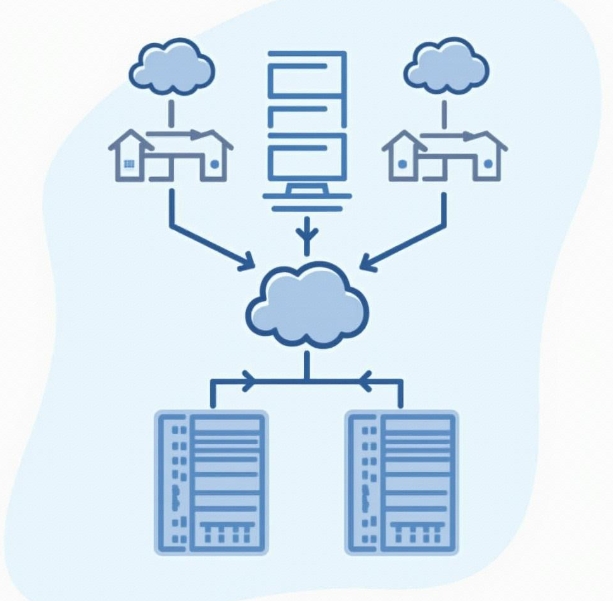The Impact of Cloud Computing on Software Development: Agile Development and Cross-Platform Deployment
- latest articles
- 1.DApp Development & Customization: Merging Diverse Market Needs with User Experience 2.Analysis of the Core Technical System in DApp Project Development 3.How to achieve cross-chain interoperability in Web3 projects? 4.How does the tokenization of points reconstruct the e-commerce ecosystem? 5.How to Set and Track Data Metrics for a Points Mall? 6.What is DApp Development? Core Concepts and Technical Analysis 7.Inventory of commonly used Web3 development tools and usage tips 8.Development of a Distribution System Integrated with Social E-commerce 9.Six Key Steps for Businesses to Build a Points Mall System 10.What is DApp Development? A Comprehensive Guide from Concept to Implementation
- Popular Articles
- 1.Future Trends and Technology Predictions for APP Development in 2025 2.Analysis of the DeFi Ecosystem: How Developers Can Participate in Decentralized Finance Innovation 3.From Zero to One: How PI Mall Revolutionizes the Traditional E-commerce Model 4.DAPP Development | Best Practices for Professional Customization and Rapid Launch 5.Recommended by the Web3 developer community: the most noteworthy forums and resources 6.From Cloud Computing to Computing Power Leasing: Building a Flexible and Scalable Computing Resource Platform 7.How to Develop a Successful Douyin Mini Program: Technical Architecture and Best Practices 8.Shared Bike System APP: The Convenient Choice in the Era of Smart Travel 9.How to Create a Successful Dating App: From Needs Analysis to User Experience Design 10.From Design to Development: The Complete Process of Bringing an APP Idea to Life
In today's era of rapidly advancing technology, cloud computing has become the core driving force behind the development of various industries. It has not only redefined how data storage and computing resources are accessed but also transformed the entire ecosystem of software development. With the widespread adoption of cloud computing, the software development process has become more flexible, efficient, and convenient, especially in agile development and cross-platform deployment, where the role of cloud computing is particularly significant. This article will explore how cloud computing impacts software development, focusing on its applications and challenges in agile development and cross-platform deployment.
I. Overview of Cloud Computing
Cloud computing is a model that provides computing resources, storage, and application services over the internet. Unlike traditional on-premises computing resources, cloud computing relies on distributed data centers, allowing users to rent computing and storage capabilities on-demand without investing in expensive hardware. The three main service models of cloud computing include Infrastructure as a Service (IaaS), Platform as a Service (PaaS), and Software as a Service (SaaS). These service models not only significantly reduce technological investments for enterprises but also offer greater flexibility and convenience for software development.
The Relationship Between Cloud Computing and Software Development
With the continuous advancement of cloud computing technology, an increasing number of developers and enterprises are adopting cloud computing as a core component of their development infrastructure. The high-efficiency computing power, elastic storage, automated deployment, and globally distributed environment provided by cloud computing have overcome many traditional limitations in software development. For example, developers no longer need to worry about hardware constraints of local servers or handle complex resource configurations, as cloud computing's virtualization technology offers higher resource utilization and greater scalability.

II. The Role of Cloud Computing in Driving Agile Development
Agile development is a methodology that emphasizes flexibility, rapid response to changes, and customer needs. Its core idea is to deliver product value early through short-cycle iterations and continuous delivery to meet rapidly changing market demands. The impact of cloud computing on agile development is mainly reflected in the following aspects:
1. Improving Development Efficiency
Cloud computing provides developers with the ability to access computing resources on-demand, eliminating reliance on traditional hardware and local servers. This means development teams can quickly configure and deploy development environments, reducing the time and cost associated with environment setup. In traditional development, developers often need to set up databases, operating systems, and development tools locally, which can take weeks. With cloud platforms, developers can use automated scripts to quickly set up environments, enabling rapid development and iteration.
For example, developers can leverage PaaS (Platform as a Service) environments provided by cloud services to focus on application development and functionality without worrying about underlying hardware. Through IaaS, developers can flexibly choose cloud computing resources, dynamically adjust development needs, and optimize resource usage.
2. Promoting Continuous Integration and Continuous Delivery (CI/CD)
Cloud computing provides an ideal platform for Continuous Integration (CI) and Continuous Delivery (CD). CI/CD is an automated software development process that helps teams detect code quality and errors in real-time during development, enabling quick fixes and deployments. The automated build, test, and deployment tools offered by cloud platforms can greatly simplify this process.
For example, automated testing environments can be easily set up on cloud platforms. When developers submit code, the testing environment automatically starts and runs tests to ensure code quality meets standards. If the tests pass, the code is automatically deployed to the production environment, achieving a zero-touch and highly efficient process. The scalability and automation features of cloud computing promote the concept of "continuous delivery" in agile development, allowing software to be released more frequently and quickly, thereby better meeting customer needs.
3. Supporting Cross-Regional Team Collaboration
Cloud computing breaks down geographical barriers, enabling developers from around the world to access the same cloud platform for project collaboration and version management. This is crucial for agile development, which emphasizes teamwork and rapid feedback, requiring team members to communicate about project progress and issues in a short time.
The shared resources and collaboration tools provided by cloud platforms allow developers to easily share code, manage documents, and track tasks, with all development activities synchronized via the cloud. This is particularly important for cross-regional, cross-time-zone development teams, as it eliminates spatial and temporal obstacles, ensuring real-time collaboration on a global scale.
4. Elasticity and Shortening Development Cycles
The elasticity of cloud platforms enables development teams to dynamically adjust resources based on project needs. For example, during the initial stages of development, only a small amount of computing resources may be required, but as the project scales, computing demands can grow rapidly. Cloud computing provides the ability to scale resources on-demand, allowing development teams to adjust computing and storage resources as needed without pre-purchasing or configuring large amounts of hardware.
This enables agile development to complete iterations in a shorter time. Developers can focus on implementing business logic and functionality without worrying about infrastructure limitations.

III. Cloud Computing Support for Cross-Platform Deployment
With the diversification of software applications and end-user devices, cross-platform deployment has become a critical requirement in modern software development. Cloud computing provides an ideal solution for developing and deploying cross-platform applications by offering a unified development and deployment platform.
1. Providing a Unified Development Platform
Cloud computing offers a unified development environment through Platform as a Service (PaaS), enabling applications to run on different platforms. Traditional cross-platform development requires addressing compatibility issues across various operating systems and hardware architectures. In contrast, cloud platforms provide container technologies (such as Docker) and virtualization technologies that ensure applications run in the same environment across multiple platforms. Developers can focus on application functionality without worrying about cross-platform compatibility.
For example, developers can package applications using Docker containers and deploy them to different operating systems and devices. Whether on Linux, Windows, or Mac OS, applications can run in the same cloud environment, ensuring consistency in cross-platform deployment.
2. Supporting Multi-Platform Resource Management
Cloud computing platforms typically support multiple operating systems and device types, including traditional PCs, mobile devices, and IoT devices. Developers can easily manage and schedule resources for applications across different platforms via the cloud, ensuring applications run smoothly on various devices.
For example, an application may need to run on PCs, mobile devices, and embedded systems. Cloud platforms can centrally manage and provide the necessary computing resources and data support for each terminal. This allows developers to avoid redundant development and maintenance efforts across multiple platforms, saving time and costs.
3. Simplifying Application Release and Updates
The continuous integration and continuous delivery capabilities of cloud platforms are not only suitable for single-platform development but also support the release and updates of multi-platform applications. Through the automated deployment features of cloud platforms, developers can release applications to multiple platforms with a single click and perform customized configurations and optimizations based on the characteristics of each platform.
Additionally, the global deployment capabilities of cloud computing enable applications to quickly reach global markets, addressing challenges related to cross-border deployment and multi-language version support. Developers can achieve cross-border, cross-platform deployment and management via cloud platforms, ensuring consistency and availability worldwide.
IV. Challenges and Future Development of Cloud Computing
Although cloud computing offers numerous benefits for agile development and cross-platform deployment, it also presents new challenges. For example, security and privacy protection have become critical considerations for developers using cloud platforms. Developers must ensure data security in the cloud by implementing effective encryption and authentication measures to prevent data breaches and misuse.
Furthermore, with the rapid advancement of cloud computing technology, selecting the appropriate cloud service model and platform has become a significant challenge for developers. Different cloud service providers offer varying service features and technical architectures, requiring development teams to choose the right cloud platform based on project needs and budget.
Looking ahead, with the development of emerging technologies such as 5G and edge computing, cloud computing will play an increasingly important role in software development. Particularly in fields like IoT, artificial intelligence, and big data, cloud computing will provide developers with more flexible and efficient development environments.
Conclusion
Cloud computing has profoundly impacted all aspects of software development, especially in agile development and cross-platform deployment. It not only provides powerful computing resources and flexible deployment methods but also promotes automation and globalization in the development process. Through cloud computing, developers can conduct agile development more efficiently, respond quickly to market demands, and achieve seamless deployment of cross-platform applications. Although cloud computing faces some challenges, with continuous technological advancements, it will undoubtedly remain a core driving force in the future of software development.
-

Applications and Challenges of Cloud Computing in the Internet of Things (IoT)
With the continuous advancement of information technology, cloud computing and t···
-

Integration of Cloud Computing and Artificial Intelligence: Enhancing Intelligent Applications
With the rapid advancement of technology, cloud computing and artificial intelli···
-

Data Security and Privacy Protection in Cloud Computing Applications
With the continuous advancement of information technology and the rapid developm···

 Blockchain
Blockchain










